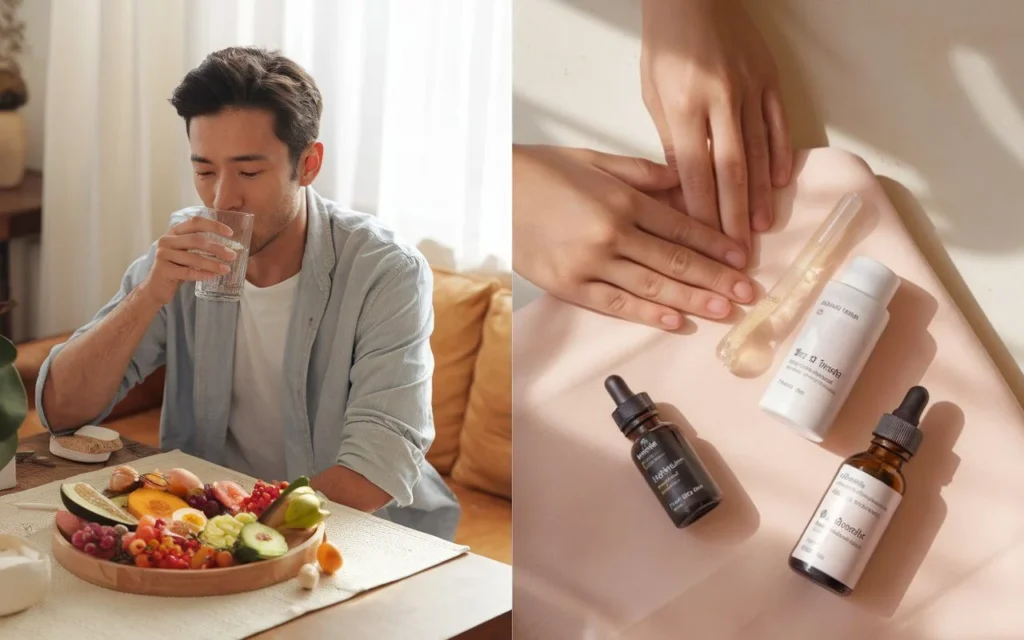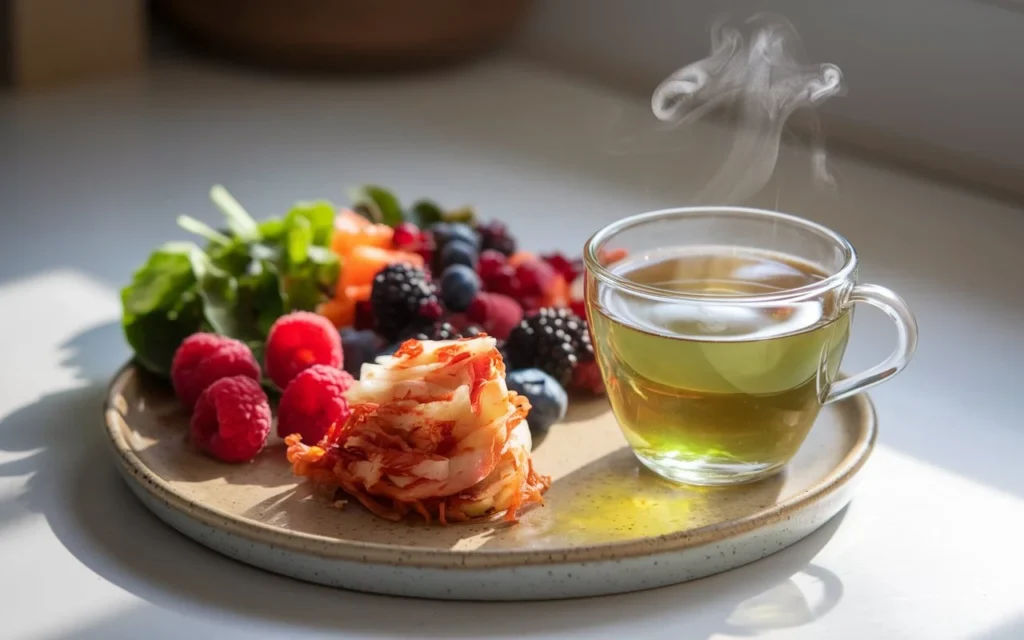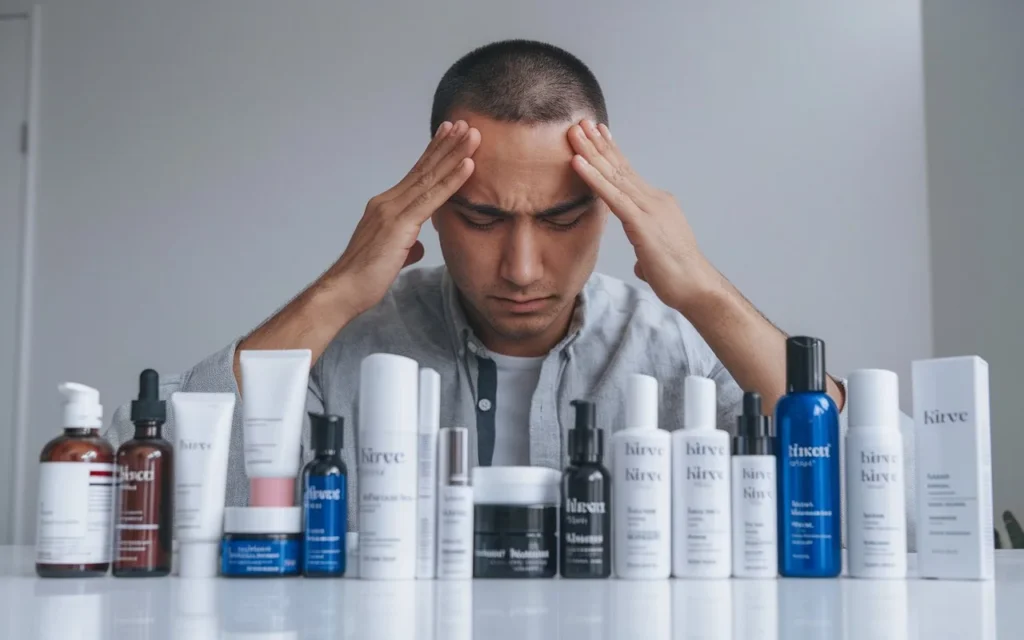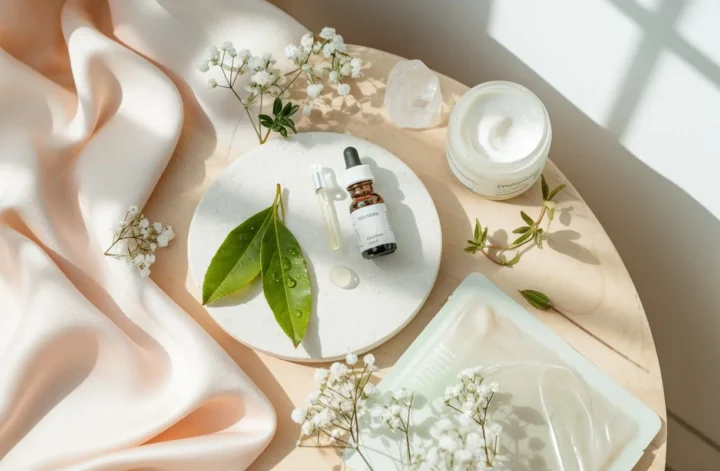Korean skincare has transformed the way people care for their skin, offering a comprehensive and effective path to healthy and glowing skin. The 10-step Korean skincare routine is renowned for its detailed process and ability to be tailored to individual needs. This guide will explain each step clearly, so you can easily follow it, no matter your skin type is oily, dry, sensitive, or combination.
Contents
- 1 Internal vs. External Skincare Practices
- 2 10-Step Korean Skincare Routine
- 3 The Role of Diet in Korean Skincare
- 4 The Science Behind Korean Skincare
- 5 Adapting the Routine to Your Skin Type
- 6 Common Myths About the 10-Step Korean Skincare Routine
- 7 Resources for Korean Skincare Enthusiasts
- 8 FAQs
- 9 Conclusion
Internal vs. External Skincare Practices

While external skincare, like following the 10-Step Korean Skincare schedule, is essential, it’s the holistic approach to self-care that truly maximizes the benefits. While eating nutrient-rich, anti-inflammatory foods, staying hydrated, and practicing moderation also work with your skincare routine to keep your skin glowing, clear, and healthy.
Thus, embracing both the external 10-step korean skincare steps and an inner focus on good nutrition will ensure that your skin is not only treated on the surface but nourished from within.
10-Step Korean Skincare Routine

The 10-step Korean skincare plan is more than just skincare; it’s a part of self-care that prioritizes consistent care for radiant skin. Each of the step in 10-step korean skincare serves a specific purpose, working together to cleanse, hydrate, nourish, and protect your skin. This routine helps address a wide range of skin concerns and maintain a glowing complexion over time. Let’s dive into each step and explore how to adapt it to suit your skin type and concerns.
Benefits of the 10-Step Korean Skincare Routine
- Deep hydration for smoother, plumper skin.
- Helps prevent wrinkles, acne, and other skin issues.
- Promotes a glowing, even complexion.
- Offers a tailored approach to meet unique skin needs.
- Encourages self-care and relaxation through a structured routine.
Step 1: Oil-Based Cleanser
An oil-based cleanser is the first step to effectively remove makeup, sunscreen, and excess oils from your skin. This gentle cleanser doesn’t strip the skin, making it ideal for all skin types, especially oily and combination skin. Popular choices include natural oil-based cleansers featuring ingredients like green tea, coconut and argan oil.
Tip: Massage the cleanser onto dry skin in circular motions before rinsing with warm water to dissolve impurities effectively.
Step 2: Water-Based Cleanser
The second cleansing step involves a water-based cleanser to eliminate any residue left behind by the oil cleanser. It removes sweat and dirt, ensuring a thorough cleanse. While foaming cleansers are effective, opt for a gentle, non-foaming formula if you have dry or sensitive skin.
Reminder: Double cleansing is a cornerstone of the 10-step Korean skincare routine, ensuring your skin is a clean canvas for the next steps.
Step 3: Exfoliation
Exfoliating removes dead skin cells, unclogs pores, and improves your skin’s texture. This step is essential 10-step korean skincare routine but should only be done 1-2 times per week to avoid irritation. Chemical exfoliants like AHAs (alpha hydroxy acids) or BHAs (beta hydroxy acids) are great for tackling uneven skin tone or acne-prone areas.
Tip: Be cautious with exfoliation if you have sensitive or dry skin; over-exfoliation can cause redness or dryness.
Step 4: Toner
A toner prepares your skin for better absorption of the products that follow. It balances your skin’s pH and hydrates it. Hydrating toners with ingredients like hyaluronic acid work well for dry skin, while toners with astringent properties help control oil in oily skin types.
Note: This step is particularly beneficial for 10-step korean skincare, tailored to oily acne-prone skin, as it helps soothe and prep the skin.
Step 5: Essence
Essence is a lightweight product packed with hydrating and skin-nourishing ingredients. Essence works wonders for improving your skin’s texture and elasticity, just as a trendy haircut can transform your look, boosting your overall confidence. Essences are often infused with ingredients like fermented extracts or glycerin, which boost hydration.
Tip: Apply essence by gently patting it onto your skin with your hands for maximum absorption.
Step 6: Treatments (Serums and Ampoules)
Targeted treatments like serums and ampoules address specific skin concerns such as acne scars, wrinkles, or dark spots. Serums with active ingredients like vitamin C, niacinamide, or retinol are highly effective.
Keyword Tip: If hyperpigmentation is a concern, opt for brightening serums containing niacinamide or licorice root extract.
Step 7: Sheet Masks
Sheet masks are a popular part of the 10-step korean skincare routine, offering an intense boost of hydration and nutrients. Use them 2-3 times a week or whenever your skin needs extra care. They’re available in a variety of formulations, targeting dryness, dullness, or even acne.
Tip: To achieve glowing skin, try sheet masks infused with ingredients like aloe vera, collagen, or snail mucin.
Step 8: Eye Cream
The delicate skin around your eyes benefits from the targeted care of an eye cream. Eye creams help reduce puffiness, dark circles, and wrinkles. Look for formulas containing peptides, caffeine, or hyaluronic acid for effective results.
Reminder: For those focusing on anti-aging, eye creams are a must-have in 10-step korean skincare method for wrinkles.
Step 9: Moisturizer
Moisturizer locks hydration and forms a protective barrier on your skin. The texture of the moisturizer—whether it’s a cream, lotion, or gel should match your skin type. Rich creams are perfect for dry skin, while lightweight gel moisturizers suit oily or combination skin.
Tip: Applying moisturizer while your skin is slightly damp can enhance its absorption and effectiveness.
Step 10: Sunscreen (Day) / Sleeping Mask (Night)
The final step of 10-step korean skincare formula varies depending on the time of day. In the morning, sunscreen is vital to protect your skin from harmful UV rays and prevent premature aging. At night, a sleeping mask provides deep hydration and helps repair your skin while you sleep.
Keyword Tip: Consistent use of sunscreen is a cornerstone of a Korean skincare routine for glowing skin.
The Role of Diet in Korean Skincare

In Korean skincare culture, beauty is often seen as a reflection of inner health, making diet a crucial part of the skincare routine. Just like carefully chosen suit accessories complete a formal look, a balanced diet and lifestyle choices complement a great skincare routine.While the 10-Step Korean Skincare provides external care, internal health through proper nutrition plays a complementary role in achieving radiant and clear skin. Here’s how food and lifestyle impact skin health:
1. Traditional Korean Diet for Clear Skin:
Koreans have long known that a diet rich in fresh vegetables, fermented foods, and antioxidant-rich ingredients supports healthy skin. Foods like kimchi, seaweed, and green tea are staples in Korean diets that benefit the skin. These foods are loaded with nutrients, vitamins, and probiotics, which help cleanse the body and fight inflammation.
- Kimchi: Packed with probiotics, it helps balance the gut and, by extension, promotes clear skin.
- Green Tea: Rich in antioxidants, particularly EGCG, green tea can combat the signs of aging and reduce skin irritation and redness.
2. Hydration:
A hydrated body reflects on the skin, making water intake essential. Many Koreans drink plenty of water, along with beverages like barley tea and green tea, which hydrate and cleanse the body. Drinking sufficient water also supports the function of other organs and helps eliminate toxins, keeping your skin radiant and youthful.
3. Antioxidant-Rich Foods:
A diet rich in vitamin C, vitamin E, and beta-carotene supports the skin’s natural ability to heal and fight free radicals. Korean skincare culture embraces antioxidant-rich foods, such as sweet potatoes, citrus fruits, berries, and leafy greens.
- Berries and citrus fruits: Known for their high vitamin C content, these fruits promote collagen production, which is essential for firm and youthful skin.
- Sweet Potatoes: Rich in beta-carotene, they are known to combat wrinkles and dry skin, making them a vital component of a skin-friendly diet.
4. Fermented Foods for Healthy Gut Flora:
Fermented foods like yogurt, kimchi, and soy sauce not only promote gut health but also contribute to better digestion. A healthy gut leads to fewer skin issues like acne and eczema because it helps control inflammation levels within the body.
Korean skincare culture closely links gut health to clear, glowing skin, considering it as important as your external routine. By promoting good bacteria and enhancing digestion, these foods can help achieve a balanced, healthy complexion.
5. The Korean Focus on Moderation:
Dietary practices in Korean culture emphasize moderation over indulgence. Reducing the intake of heavy fats, refined sugars, and processed foods can prevent breakouts, improve overall skin texture, and support your skincare goals. A balanced diet that provides nutrients without excess oil or sugar contributes to reduced skin flare-ups and supports your daily skin care regimen.
The Science Behind Korean Skincare

Korean skincare products are known for their effectiveness, and this is backed by science. Each step and ingredient has a specific purpose, carefully chosen to support your skin’s health and appearance.
Hyaluronic Acid – A Moisture Powerhouse
Hyaluronic acid is a key ingredient in korean skincare products due to its incredible ability to attract and hold moisture. It can retain up to 1,000 times its weight in water, which makes it a fantastic hydrator. This helps keep the skin plump, smooth, and hydrated, reducing the appearance of fine lines and wrinkles.
Vitamin C – Brightens and Protects
Vitamin C is a potent antioxidant that helps brighten the skin by reducing hyperpigmentation and dark spots. It also plays a key role in boosting collagen production, keeping the skin firm and youthful. By protecting the skin from free radicals, vitamin C can help defend against environmental damage like pollution and UV rays.
AHA/BHA – Exfoliation at the Cellular Level
Alpha Hydroxy Acids (AHAs) and Beta Hydroxy Acids (BHAs) are gentle exfoliants that work at the surface of your skin and inside your pores. AHAs like glycolic acid remove dead skin cells, revealing a fresh, even skin tone. BHAs, like salicylic acid, penetrate pores, helping to clear up acne and blackheads by breaking down the oil and buildup inside.
Centella Asiatica – Soothing and Healing
Centella Asiatica, often found in Korean skincare, is known for its ability to soothe and heal damaged skin. It has anti-inflammatory properties, making it ideal for calming irritated or sensitive skin. It also promotes collagen production, which supports the skin’s elasticity and reduces scarring.
Niacinamide – Calms and Balances
Niacinamide (Vitamin B3) is another popular ingredient. It helps balance the skin’s oil production, making it beneficial for both oily and dry skin types. It also reduces redness and blotchiness, while strengthening the skin’s barrier to protect it from external pollutants.
Adapting the Routine to Your Skin Type

For Oily Skin
- Opt for lightweight, oil-free products.
- Use gel-based moisturizers and mattifying treatments.
For Dry Skin
- Prioritize hydrating products with hyaluronic acid and ceramides.
- Avoid harsh exfoliants or drying cleansers.
For Sensitive Skin
- Choose fragrance-free, hypoallergenic products.
- Test new products on a small patch of skin before full application.
For Combination Skin
- Use lightweight products on oily areas and richer products on dry spots.
- Consider multi-masking for targeted care.
For Acne-Prone Skin
- Focus on products with salicylic acid, tea tree oil, or Centella Asiatica.
- Avoid heavy, pore-clogging formulations.
Common Myths About the 10-Step Korean Skincare Routine

Despite its growing popularity, there are several myths surrounding the 10-step Korean skincare drill. Let’s debunk these misconceptions and highlight the truth:
It Takes Too Much Time
One of the most common myths is that the 10-step korean skincare routine is time-consuming and impractical for daily use. However, the routine can be adjusted to fit your schedule. While all ten steps are recommended, you can focus on the essential ones like cleansing, toning, and moisturizing, especially on busy days. The routine is meant to be flexible, not overwhelming.
It’s Only for Women
Skincare is for everyone, regardless of gender. Just as both old money and preppy styles are expressions of personal choice that appeal to different tastes, the 10-step Korean skincare routine can be customized for any skin type or personal preference, offering benefits for everyone.
It’s Expensive
While Korean skincare offers many premium products, it’s possible to create an effective routine with affordable options. There are plenty of budget-friendly choices at various price points that provide the same benefits as higher-end products. With careful selection, the 10-step korean skincare routine can fit most budgets.
More Products Always Mean Better Results
Some think that using more products leads to faster and better results. However, layering too many products on your skin can sometimes cause irritation, especially for sensitive skin types. It’s important to choose products that match your skin’s needs and to avoid overloading with unnecessary steps. Quality over quantity is key.
You Can’t Skip Any Step
The 10-step korean skincare routine is designed to be comprehensive, but it doesn’t mean you have to follow it perfectly every time. Depending on your skin type and lifestyle, you can omit or reduce certain steps. For example, exfoliating 1-2 times a week is often enough; daily exfoliation is not necessary. It’s more about consistency than strictly completing every step daily.
By understanding these common myths and adopting a balanced, customized approach, you can enjoy the true benefits of the 10-step Korean skincare routine without feeling overwhelmed.
Resources for Korean Skincare Enthusiasts
Here are some helpful resources to deepen your knowledge about 10-step korean skincare routine and enhance your skincare journey.
Korean Beauty Blogs and Websites:
- Korean Skincare: Offers expert advice, product reviews, and skincare tips.
- The Klog: Focuses on Korean beauty trends and skincare routines.
Books:
- “The Little Book of Skin Care” by Charlotte Cho – A great introduction to Korean skincare and lifestyle.
- “Skincare: The Ultimate No-Nonsense Guide” by Caroline Hirons – Covers the science of skincare and product recommendations.
YouTube Channels:
- Liah Yoo – A skincare expert sharing product reviews and DIY tips.
- James Welsh – Focused on honest reviews and skincare science.
Explore these resources to find products, tips, and support for your skincare journey. With the right tools and information, mastering the 10-step Korean skincare routine becomes even easier.
Moreover, also read these articles to boost up your personality by exploring old money vs preppy style for timeless fashion choices, 16 stunning suit accessories to elevate your wardrobe, and trending haircuts to refresh your look and keep up with the latest trends.
FAQs
What is the best Korean skincare routine for dry skin?
For dry skin, focus on hydrating steps like essences, toners, and moisturizers with ingredients like hyaluronic acid. Avoid products with alcohol or harsh exfoliants.
How do I follow a 10-step Korean skincare routine?
The routine includes these steps: oil cleanser, water cleanser, exfoliation (1-2 times weekly), toner, essence, treatment, sheet mask, eye cream, moisturizer, and sunscreen or sleeping mask.
What’s the ideal Korean skincare routine for acne-prone skin?
For acne-prone skin, use products with salicylic acid, tea tree oil, or Centella Asiatica. Focus on lightweight, non-comedogenic products.
What products are used in a Korean skincare routine?
Key products include cleansing balms, foaming cleansers, toners, essences, serums, sheet masks, eye creams, moisturizers, and sunscreen or sleeping masks.
How do I customize the Korean skincare routine for oily skin?
Use lightweight, oil-free formulations. Gel-based moisturizers and mattifying products can help reduce shine.
What are the essential steps in 10-step Korean skincare routine?
The main steps are cleansing, exfoliating, hydrating, treating specific concerns, moisturizing, and protecting your skin with sunscreen.
Conclusion
The 10-step Korean skincare routine is a comprehensive approach to achieving healthy, glowing skin. By consistently following these steps and choosing the right products for your needs, you can transform your skin over time. Start your journey today and enjoy the radiant results!

